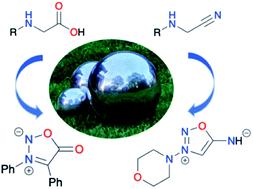A mechanochemical approach to the synthesis of sydnones and derivatives†
Abstract
Sydnones are heterocyclic compounds which display important biological activities, including their abilities to react in 1,3-dipolar additions for applications in the development of new prodrugs. Capitalizing on our preliminary work on the mechanosynthesis of sydnones, an extension of this work to two related families of molecules, diarylsydnones and iminosydnones is reported. A ball-milling approach towards the synthesis of diaryl sydnones was developed, a necessary step for the synthesis of potential sydnone-based ligands of metal complexes. A mechanochemistry-based synthesis of iminosydnones was optimized, including the preparation of active pharmaceutical ingredients (API) related to feprosidnine, linsidomine, mesocarb and molsidomine. This work demonstrated that the ball-milling procedures were efficient and time saving through avoiding purification steps, and reduced the use of organic solvents.

- This article is part of the themed collection: Mechanochemistry: Fundamentals, applications and future


 Please wait while we load your content...
Please wait while we load your content...